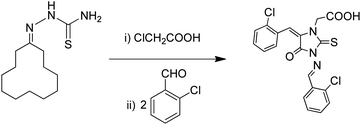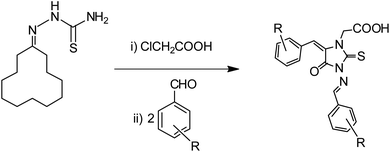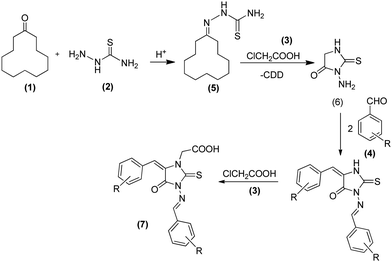Cyclododecanone as a recyclable protecting group for the synthesis of highly functionalized 3-amino-2-thiohydantoins from conventional starting materials†
Munusamy Sathishkumar,
Gunasekar Ramachandran and
Kulathu Iyer Sathiyanarayanan*
Chemistry Division, School of Advanced Sciences, VIT University, Vellore-632014, Tamilnadu, India. E-mail: sathiya_kuna@hotmail.com; Fax: +914162243092
First published on 16th January 2014
Abstract
A simple and efficient approach has been developed for the synthesis of highly substituted 3-amino-2-thiohydantoins using cyclododecanone as a protecting group and thiosemicarbazide, chloroacetic acid and substituted benzaldehyde as reactants. This high yielding (79–96%) protocol is a milder alternative to the traditional method that uses unprotected thiosemicarbazide. It was identified that the preferred pathway is the deprotection of 3-amino-2-thiohydantoins followed by the attack of chloroacetic acid on a secondary nitrogen with subsequent formation of the Knoevenagel product and its reaction with imine leading to the final product.
1. Introduction
Synthesizing molecules that have maximum structural diversity and complexity using a minimum number of synthetic steps for the rapid generation of highly functionalised molecules with interesting properties represents a major challenge to modern synthesis. In this context, multicomponent reactions (MCRs) have played an important role in these processes.1 Because of their convergent nature, superior atom economy and straightforward experimental procedures, MCRs have been investigated extensively in organic and diversity oriented synthesis. In a similar way, many MCRs such as Passerini reaction,2 Mannich reaction,3 Petasis reaction,4 and Ugi reaction,5 have been developed.3-Amino-2-thiohydantoins are five membered heterocyclic compounds containing two nitrogen atoms in the ring with privileged structures as they belong to a class of compounds with diverse biological activity.6 Many biological applications such as antiarrhythmics,7 anticonvulsants,8 antitumor,9 anti-inflammatory,10 antiandrogens11 and aldose reductase inhibitors12 have been unearthed from thiohydantoins. These can also act as herbicidal and fungicidal reagents.13 Recently, a new class of substituted thiohydantoins were synthesized and tested as DNA fluorescence probes, which showed excellent results.14 Considering their potential applications, various different synthetic methods have been developed to prepare 3-amino-2-thiohydantoins and its derivatives. Some of the most commonly used methods are the Bucherer–Bergs reaction, but the use of KCN and the special condition required for this reaction restricts this method.15 The coupling reaction between α-amino acids with ammonium thiocyanate or isothiocyanate leads to the product 2-thiohydantoin.16,17 Another convergent method is the three components reaction, combining 1,2-diaza-1,3-dienes, primary amines, and isothiocyanates.18
Functional group protection/deprotection plays an important role in organic synthesis. The protection of amines is one of the most fundamental and useful transformations to decrease the nucleophilicity of the amino group in order to perform other transformations in the molecule. One of the major applications of protecting group strategy is the synthesis of peptides from amino acids.19
Now we report a recyclable protecting group approach for the synthesis of some highly functionalized 3-amino-2-thiohydantoins derivatives using simple and easily available starting materials. These compounds are thiosemicarbazide, benzaldehyde, chloroacetic acid and cyclododecanone (CDD) functioning as protecting group. In this method, we used CDD to protect free amino group present in the thiosemicarbazide to avoid unwanted side product20 so that the yield could be improved. Cyclododecanone is a typical cyclic ketone and exists in solid form. It easily reacts with free amino group and forms stable ketimine in the presence of an acid catalyst. Based on the above considerations we chose CDD as the protecting group to protect free amino group in thiosemicarbazide for the synthesis of highly substituted 3-amino-2-thiohydantoins. To the best of our knowledge, this is the first time a protecting group approach is used for the synthesis of 3-amino-2-thiohydantoins, to avoid cross reactions, leading to substantial yield and less reaction time. Though many protecting groups are available for the protection of the amino group, this method is very easy to execute, and the reusability of protecting group is also possible. As part of our continued interest in establishing multicomponent reactions,21 we undertook a detailed investigation on the stepwise formation of 3-amino-2-thiohydantoins. The key objectives of this work are the use of a protecting group approach for the synthesis of 3-amino-2-thiohydantoins and the identification of preferred mechanistic pathway for the formation of 3-amino-2-thiohydantoins.
2. Results and discussion
2.1. Solvent screening for assembling 3-amino-2-thiohydantoins
3-Amino-2-thiohydantoin derivatives (7) were prepared by two step sequence that is outlined in Table 1. In the first step, we carried out a reaction between CDD and thiosemicarbazide in order to protect the free amino group in thiosemicarbazide to avoid the formation of nucleophilic substituted product with chloroacetic acid in the presence of an acid catalyst, and we got thiosemicarbazone quantitatively. The cyclisation of the 3-amino-2-thiohydantoins ring system was brought out via reactions between protected thiosemicarbazide (2), chloroacetic acid (3) and substituted benzaldehyde (4) over reflux in acetic acid medium. This protecting group protocol was found to be of wide scope in terms of high yields with no side reactions. A number of highly substituted 3-amino-2-thiohydantoins derivatives were obtained by varying the substitutions on aromatic aldehyde.| Entry | Solvent | %Yieldb |
|---|---|---|
| a Unless otherwise stated, all the reactions have been carried out by refluxing 2 mmol of (5) and 4 mmol of chloroacetic acid and 4 mmol of 2-chlorobenzaldehyde in 5 ml of solvent.b Isolated yield. | ||
| 1 | None | — |
| 2 | Acetic acid | 92 |
| 3 | Methanol | 44 |
| 4 | Ethanol | 32 |
| 5 | Isopropanol | 22 |
| 6 | DMF | — |
| 7 | DMSO | — |
| 8 | THF | — |
| 9 | DCM | — |
To optimize the reaction condition, we screened different solvents for this reaction. Protic solvents like acetic acid, methanol, ethanol, isopropanol and aprotic solvents such as THF, DCM, DMF and DMSO were screened. Among these, acetic acid was found to be the best solvent to get a good yield (Table 1). It was observed that in aprotic solvents such as THF, DCM, DMF and DMSO there was no product formation at all.
The flexibility of this reaction has been tested with various substituted benzaldehydes and cinnamaldehyde; the resultant products are listed in Table 2. Having optimized the solvent for the reaction condition, we then examined the reaction of a number of substituted benzaldehydes with chloroacetic acid and protected thiosemicarbazide. Generally the reaction proceeded well with these substrates and delivered highly substituted 3-amino-2-thiohydantoins (7a–7n) in good to excellent yields. (Table 2, entries) The results demonstrated that both the electronic feature (EWG & EDG) and the orientation of benzaldehydes have limited influence on this reaction.
| Entry | R | Product | Time (h) | Yieldb (%) | m.p (°C) |
|---|---|---|---|---|---|
| a Unless otherwise stated, all the reactions have been carried out by refluxing 2 mmol of (5) and 4 mmol of chloroacetic acid and 4 mmol of benzaldehyde in 5 ml of acetic acid.b Isolated yield. | |||||
| 1 | 2-F | 7a | 2.0 | 94 | 220–223 |
| 2 | 2-Cl | 7b | 2.5 | 92 | 213–215 |
| 3 | 3-OH | 7c | 2.5 | 91 | 283–285 |
| 4 | 3-NO2 | 7d | 2.0 | 95 | 254–257 |
| 5 | 3,4-diOH | 7e | 3.0 | 94 | 275–278 |
| 6 | 4-OCH3 | 7f | 3.0 | 83 | 210–212 |
| 7 | 4-CH3CH2 | 7g | 3.5 | 86 | 231–232 |
| 8 | 4-F | 7h | 2.5 | 92 | 246–249 |
| 9 | 4-OCH3CH2 | 7i | 3.5 | 80 | 240–243 |
| 10 | 4-CH3 | 7j | 3.0 | 85 | 221–223 |
| 11 | 4-Br | 7k | 2.5 | 89 | 217–220 |
| 12 | 4-OH | 7l | 2.0 | 91 | 292–295 |
| 13 | 4-Benzyloxy | 7m | 2.5 | 88 | 263–266 |
| 14 |  |
7n | 2.5 | 79 | 227–230 |
Another notable characteristic of this reaction is that a wide range of functional groups such as fluoro, chloro, nitro and hydroxy remain intact in the reaction condition. Since the formed product and CDD have immense polarity difference, it was decided to wash the product with n-hexane to recover CDD. This can be used a number of times for further reactions. Initially we have carried out the reaction between thiosemicarbazide and chloroacetic acid to synthesize 3-amino-2-thiohydantoins without any protecting group. But the product obtained in this reaction was a mixture of various imidazolidines as shown in Fig. 1. Thus we have protected the free amino group of thiosemicarbazide using CDD as protecting group thereby it forms stable ketimine. From these stable ketimine (protected thiosemicarbazide – (5)) we have successfully recovered CDD by deprotecting it from free amino group of thiosemicarbazide and this protecting group could be used for several times as it regenerates quantitatively, whereas with other cyclic ketone it is very difficult to recover it and separate the product from the deprotected cyclic ketone. Under the same conditions chloroacetic acid was added to the protected thiosemicarbazide to yield the desired product (6). The product thus obtained from the (5) was very selective and gave higher yield as shown in Fig. 2. Thus it clearly shows that the synthesis of 3-amino-2-thiohydantoins proceeds smoothly without any side product when the reaction was carried out in the presence of CDD as protecting group as shown in Fig. 3.
3. Conclusion
A simple and high yielding synthetic protocol has been developed for the synthesis of highly functionalized 3-amino-2-thiohydantoins using cyclododecanone as a protecting group for thiosemicarbazide. The value of this method lies in the easily available starting material, short reaction time with excellent yield and avoidance of column chromatography. Protecting group cyclododecanone can be isolated and reused for the further reactions number of times.4. Experimental section
General methods: All reactions were performed under reflux conditions and open to air. Melting points were determined in open capillary tubes and are uncorrected. 1H NMR (400 MHz) and 13C NMR (100 MHz) spectra were recorded in DMSO-d6. Chemical shifts are given in δ values referenced to TMS. All the yields mentioned in the experimental data are of isolated products unless otherwise mentioned.4.1. Synthesis of 2-cyclododecylidenehydrazine carbothiamide from CDD (5)
In an oven dried three necked RB flask mixture of CDD (2 mmol) and thiosemicarbazide (2 mmol) was taken and dissolved in ethanol (5 ml). To this 0.2 ml of acetic acid was added and refluxed for about 30 min in a water bath. The completion of the reaction was monitored from TLC and the formed precipitate was filtered, washed with water and dried.4.2. Synthesis of 2-((E) - 5-(2-fluorobenzylidine)-3-((E)-2-fluorobenzylidineamino)-4-oxo-2-thioxoimidazolidine-1-yl) acetic acid from 5a: pale yellow color solid
With 5 ml of acetic acid 2 mmol of (5) and 2 mmol of chloroacetic acid were taken in an oven dried three necked RB flask and refluxed for about 1 h. The disappearance of (5) was monitored from TLC. After the disappearance of (5) 3 mmol of 2-fluorobenzaldehyde was added and refluxed further for about 2 h. After the completion of the reaction, the reaction mass was poured into ice cooled water and the formed yellow precipitate was filtered, dried and washed with n-hexane. The obtained filtrate was dried in vacuum and the recovered CDD can be used for further reactions for a number of times.Acknowledgements
Munusamy Sathishkumar thanks Vellore Institute of Technology, Tamilnadu, India, for providing Research Associateship. The DST-FIST NMR facility at VIT University is greatly acknowledged.Notes and references
-
(a) A. Domling, Chem. Rev., 2006, 106, 17 CrossRef PubMed
; (b) D. M. D. Souza and T. J. J. Muller, Chem. Soc. Rev., 2007, 36, 1095 RSC
; (c) C. C. A. Cariou, G. J. Clarkson and M. Shipman, J. Org. Chem., 2008, 73, 9762 CrossRef CAS PubMed
; (d) M. P. G. Pedro, M. S. D. C. Pedro, F. Montalbano and N. R. Candeias, Chem. Rev., 2010, 110, 6169 CrossRef PubMed
; (e) A. V. Artemev, N. K. Gusarova, S. F. Malysheva, V. I. Mamatyuk, Y. V. Gatilov, I. A. Ushakov and B. A. Trofimov, Eur. J. Org. Chem., 2010, 6167 Search PubMed
.
-
(a) B. Julien, M. Geraldine and Z. Jieping, Org. Lett., 2010, 12, 1432 CrossRef PubMed
; (b) E. K. Laurent, G. Marie and G. Laurence, Org. Lett., 2006, 8, 5021 CrossRef PubMed
; (c) P. R. Andreana, C. Liu and S. L. Schreiber, Org. Lett., 2004, 6, 4231 CrossRef CAS PubMed
.
-
(a) S. Kobayashi and H. Ishitani, Chem. Rev., 1999, 99, 1069 CrossRef CAS PubMed
; (b) S. Kobayashi, Y. Mori, J. S. Fossey and M. M. Salter, Chem. Rev., 2011, 111, 2626 CrossRef CAS PubMed
; (c) L. W. Xu, C. G. Xia and L. Li, J. Org. Chem., 2004, 69, 8482 CrossRef CAS PubMed
; (d) S. Kobayashi, H. Kiyohara and M. Yamaguchi, J. Am. Chem. Soc., 2011, 133, 708 CrossRef CAS PubMed
.
-
(a) N. A. Petasis and I. Akritopoulou, Tetrahedron Lett., 1993, 34, 583 CrossRef CAS
; (b) N. A. Petasis and I. A. Zavialov, J. Am. Chem. Soc., 1997, 119, 455 CrossRef
; (c) N. A. Petasis, A. Goodman and I. A. Zavialov, Tetrahedron, 1997, 53, 16463 CrossRef CAS
; (d) N. A. Petasis and S. Boral, Tetrahedron Lett., 2001, 42, 539 CrossRef CAS
.
-
(a) M. Umkehrer, C. Kalinski, J. Kolb and C. Burdack, Tetrahedron Lett., 2006, 47, 2391 CrossRef CAS PubMed
; (b) J. M. Grassot, G. Masson and J. J. Zhu, Angew. Chem., Int. Ed., 2008, 47, 947 CrossRef CAS PubMed
; (c) T. Pirali, G. C. Tron and J. Zhu, Org. Lett., 2006, 8, 4145 CrossRef CAS PubMed
; (d) A. Domling and K. Illgen, Synthesis, 2005, 662 CrossRef PubMed
.
-
(a) M. J. Lee and C. M. Sun, Tetrahedron Lett., 2004, 45, 437 CrossRef CAS PubMed
; (b) D. Zhang, X. Xing and G. D. Cuny, J. Org. Chem., 2006, 71, 1750 CrossRef CAS PubMed
; (c) S. Reyes and K. Burgess, J. Org. Chem., 2006, 71, 2507–2509 CrossRef CAS PubMed
.
- H. J. Havera and W. G. Strycker, US Pat., 3,994, 904, 1976; Chem. Abstr., 1978, 86, 106586m
.
- W. K. Chui, T. H. Wong and J. C. Thenomozhiyal, J. Med. Chem., 2004, 47, 1527 CrossRef PubMed
.
-
(a) R. U. Shih, J. Wu, Y. Liu, Y. C. Liang, S. Y. Lin, M. T. Sheu and W. S. Lee, Biochem. Pharmacol., 2004, 67, 67 CrossRef PubMed
; (b) A. Takahashi, H. Matsuoka, K. Yamada and Y. Uda, Food Chem. Toxicol., 2005, 43, 521 CrossRef CAS PubMed
; (c) A. Al-Obaid, H. I. El-Subagh, A. L. Khodair and M. M. A. Elmazar, Anti-Cancer Drugs, 1996, 7, 873 CrossRef CAS PubMed
.
- K. E. Schulte and V. Von Weissenborn, Eur. J. Med. Chem., 1978, 13, 25 CAS
.
- A. Claussuer, F. Goubet and J. J. Teutsch, Pct INT. Appl. WO 97 19064, 1997; Chem. Abstr., 1997, 127, 50640v
.
- R. Sarges and R. Sehnur, US Pat., 4127665, 1978; Chem. Abstr., 1979, 90, 87464j
.
-
(a) T. Mizuno, T. Kino, T. Ito and T. Miyata, Synth. Commun., 2000, 30, 1675 CrossRef CAS
; (b) C. J. Mappes, E. H. Pommer, C. Rentzea and B. Zeeh, US Pat., 4, 198, 423, 1980; Chem. Abstr., 1980, 93, 71784
.
- A. G. Majouga, A. V. Udina, E. K. Beloglazkina, D. A. Skvortsov, M. I. Zvereva, O. A. Dontsova, N. V. Zyk and N. S. Zefirov, Tetrahedron Lett., 2012, 53, 51 CrossRef CAS PubMed
.
-
(a) E. Ware, Chem. Rev., 1950, 46, 403 CrossRef CAS
; (b) R. Sarges, S. W. Goldstein and W. M. Welch, J. Med. Chem., 1990, 33, 1859 CrossRef CAS
; (c) C. Montagne and M. Shipman, Synlett, 2006, 2203 CAS
.
- S. Reyes and K. Burgess, J. Org. Chem., 2006, 71, 2507 CrossRef CAS PubMed
.
-
(a) J. P. Li, C. M. Ma and G. R. Qu, Synth. Commun., 2005, 35, 1203 CrossRef CAS PubMed
; (b) A. Innocenti, A. Casini, M. C. Alcaro, M. Papini, A. Scozzafava and C. T. Supuran, J. Med. Chem., 2004, 47, 5224 CrossRef CAS PubMed
; (c) H. Elokdah, T. S. Sulkowsk, M. Abou-Gharbia, J. A. Butera, S. Y. Chai, G. R. McFarlane, M. L. McKean, J. L. Babiak, S. J. Adelman and E. M. Quinet, J. Med. Chem., 2004, 47, 681 CrossRef CAS PubMed
; (d) W. B. Yeh, M. J. Lin, M. J. Lee and C. M. Sun, Mol. Diversity, 2003, 8, 185 CrossRef
; (e) T. B. Johnson, A. J. Hill and E. B. Kelsey, J. Am. Chem. Soc., 1920, 42, 1711 CrossRef CAS
.
- O. A. Attanasi, S. Bartoccini, G. Favi, G. Giorgi, F. R. Perrulli and S. Santeusanio, J. Org. Chem., 2012, 77, 1161 CrossRef CAS PubMed
.
- C. Agami and F. Couty, Tetrahedron, 2002, 58, 2701 CrossRef CAS
.
- V. K. Pandey, Z. Tusi, M. Tandon, M. N. Joshi and S. K. Bajpai, Indian J. Chem., Sect. B: Org. Chem. Incl. Med. Chem., 2003, 42, 2583 Search PubMed
.
-
(a) G. Ramachandran, N. S. Karthikeyan, P. Giridharan and K. Sathiyanarayanan, Org. Biomol. Chem., 2012, 10, 5343 RSC
; (b) N. S. Karthikeyan, G. Ramachandran, R. S. Rathore and K. Sathiyanarayanan, Asian J. Org. Chem., 2012, 1, 173 CrossRef
; (c) V. Sathesh, M. Sathishkumar, G. Ramachandran, R. S. Rathore and K. Sathiyanarayanan, RSC Adv., 2013, 3, 23035 RSC
; (d) B. Umamahesh, V. Sathesh, G. Ramachandran, M. Sathishkumar and K. Sathiyanarayanan, Catal. Lett., 2012, 142, 895 CrossRef CAS
.
Footnote |
| † Electronic supplementary information (ESI) available. See DOI: 10.1039/c3ra47680d |
| This journal is © The Royal Society of Chemistry 2014 |





